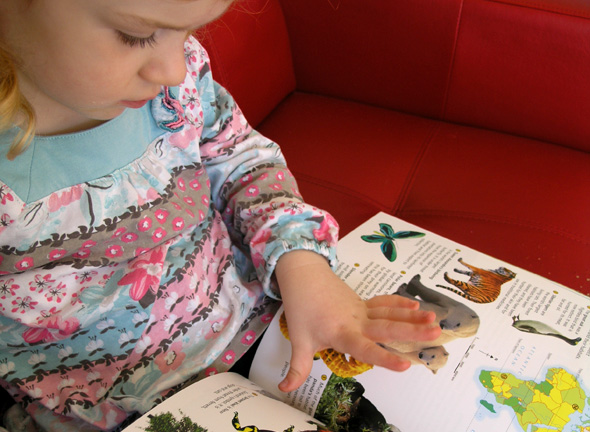Literacy Spot #41: Literacy Learning with Maps
Maps are a fun way to engage pre- and early readers with the concept that printed symbols communicate meaning. The map (whether real or homemade) provides a wonderful, hands-on, motivating context for learning.
Which sort of map would your child most like to play with?
Treasure maps
Whether it be pirate play, exploring outer space or birthday surprises, treasure maps are fun for children of all ages. This previous post shares 5 ways with treasure maps suitable for pre-readers through to older children. Or check out these ideas from the Playopedia archives;
- Pirate Play!
- Floor Plan Treasure Hunt
- Alphabet Box
- Going on a Photo Hunt
- Create Your Own Zoo Maps
Zoo (or other venue) maps
Picking up a venue map can lead to lots of follow up imaginary (and literacy) play once you are home again! Immy made the ‘zoo’ shown above after a recent visit to the Perth Zoo with her Dad. An activity she has enjoyed over and over again, pretty much each time we have visited the zoo.
City map
Heading to a new town or city to explore on your next holiday? Involve your child in the excursion planning by picking up a range of tourist maps and showing them how to use them. Tourist maps often use symbols as well as words for key locations, which is just perfect for pre-readers.
Street directory
Add a street directory to your child’s imaginary play. Check out this post for ideas on how to introduce a street directory to your child’s play.
World map
Whether it be a wall map, placemat or children’s atlas, world maps have the potential to engage a young child with the wider world in which they live. For ideas for introducing maps to your child, check out Vanessa Rough’s article, Playing with Maps, in the first issue of Play Grow Learn.



I love the idea of using other kinds of maps (not just world maps)–great ideas as always, Christie!
Maps from places and tourist attractions we’ve visited are treasured possessions of my children for ages afterwards. They inspire so many games. I love the little zoo Immy made 🙂
I love how children revisit their adventures using maps and brochures from tourist attractions 🙂
Christie, I have been catching up on your blog (my weeks are flying by at the moment with very little blogging time) and am sorry to hear that you have been so sick. I hope you are fully recovered now.
Immy’s zoo scene is so sweet. We need to make sure we keep our maps from the zoo next time we visit.
Treasure hunts are very popular here too. Perfect for my cherubs as I can usually tailor it to suit each of them. We recently did a 123 and ABC treasure Hunt. If you are interested, you can see it here:
http://etadventures.blogspot.com/2011/10/abc-and-123-treasure-hunts.html
I love these ideas. Maps are so cool.
Immy is really fascinated by them at the moment. Especially our atlas and globe 🙂
What a great idea, Christie! How nice to have a sample of another map to read as she creates her own version! Look at this map that kids made up as well: http://wp.me/p1i7AG-eF Rest areas were our source of maps this past summer!
We like using trail maps we get when camping at state parks. We plan out fantastic hikes that they could never manage yet in real life. Plus they usually have mileage numbers for the trails, so we can add up how far it would be.
Hi..I read this post a few days ago and thought “this looks neat” and bookmarked it. Then yesterday my daughter starting making maps. Maps of Africa and New York where her Dad travels too. What a timely post. Now I intend to get busy and move this activity to the top of my list! Thanks so much!
What is the brand of animals that you use?